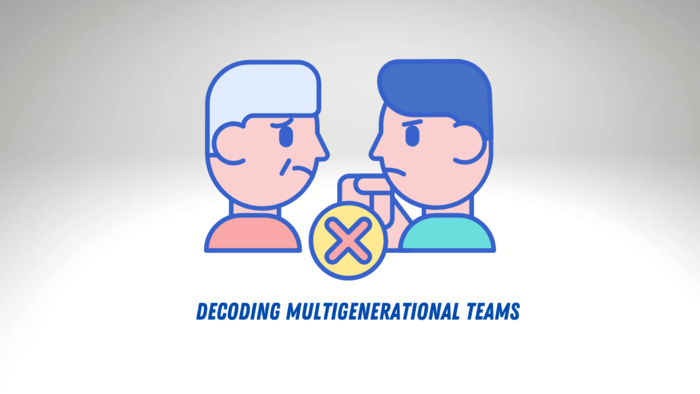Creating Accessibility during the Remote Interview Process
Image Description: A young woman with pale skin and short dark bobbed hair wears a gray cardigan. She sits in a stool at the counter in a dark kitchen with her head cupped in her left hand. She is smiling as she converses with someone via her gray laptop that is open before her on the high-top counter.
By Marion Davis
With the pandemic came a surge in remote interviews. As of 2022, many reports have declared that the remote format is the new mode of interviewing, allowing recruiters to reach a broader range of talent.
While the virtual aspect of these interviews does provide elements of convenience for many marginalized groups, further steps are necessary to ensure full accessibility.
The following sections will outline several approaches for offering accessibility, ways to increase accessibility options, and the financial benefits for an organization of developing more accessible hiring practices.
Offering Accessibility Upfront
One of the most crucial aspects of creating an accessible interview is that hiring managers offer accessible options upfront.
This action signals that the company values inclusion and also takes the burden off the interviewee of having to self-identify as a member of a marginalized group and ask for accommodations.
Accessibility is more than a legal requirement for disabled individuals as outlined by the Americans with Disabilities Act (ADA). Accessibility benefits all.
The addition of various accessibility features can provide greater access for all candidates. For instance, the increasingly more popular practice of providing a list of interview questions that will be asked in advance could be helpful not only for the neurodivergent community but also for second-language speakers of English, neurotypical people with a packed schedule and limited time to prepare, and so on with layers of intersectionality present in each category.
When a company presents flexible remote interview options, the company indicates that it values individuals’ time and it values individual talent. Apart from special circumstances, a company that utilizes a drawn-out process with eight-plus rounds of interviews to ensure candidates are a good cultural fit does little more than ensure organizational homogeneity and fatigue.
Emphasizing accessibility in the remote interview process benefits everyone.
Accessibility Options to Consider for Interviews
While there will be a wide range of accessibility needs, companies would do well to prepare and offer several options in advance for interviewees to choose as well as provide an open line of communication for people to make accommodation requests beyond this select list of options. As organizations encounter additional unique accommodation needs, they can add these accommodation options to the list.
Offering Camera-Off vs Camera-On
Job candidates may struggle with communicating that they can use Zoom but need the camera to be off. The automatic expectation for a person to be on camera during a remote interview can be stressful.
Below are some possible scenarios of quality candidates who could benefit from having the option of camera-off versus camera-on.
People with positional disabilities may need to lie flat during the chat and camera-off allows them to focus on the content of the call without facing symptoms and stress from being upright for long periods.
Neurodivergent individuals have pointed out the problem of webcam anxiety and Zoom fatigue during the pandemic and can also benefit from the option of camera-off.
Residents in rural areas may encounter low bandwidth speeds which can cause barriers to video conferencing.
The older working population has notably struggled with the switch to all-digital during the pandemic and especially with Zoom as an unfamiliar platform; when cameras-on is not enforced, this allows interviewees to call into Zoom meetings over their phone.
At the same time, some interviewees find camera-on to be more helpful. Only midway through the pandemic did Zoom provide free automated captions for the Deaf and hard of hearing community as well as people with auditory processing issues. The videoconferencing platform now offers more accessibility features.
Some Deaf or hard of hearing interviewees may prefer camera-on as they find it easier to read the other person’s lips in a video call than to read captions which can be frustratingly finicky.
The most important aspect here is that companies meet employees where they are–not holding expectations of the interviewee being present and animated on camera as a judge of whether the interviewee is a qualified candidate. There are many other contributing factors involved in a diverse talent pool, and companies should strive to support candidates in an accessible interview format.
Providing Interview Questions in Advance
A current trend in the hiring process is to provide interview questions in advance.
Even before the pandemic, the neurodivergent community was emphasizing the benefits of outlining in advance who all would be involved in interviews, what questions would be asked, and so forth.
During the pandemic, sending interview questions to all people became synonymous with efficiency for both hiring managers and candidates–and thereby demonstrating consideration of candidates’ time. Candidates could better understand before interviews what the hiring manager was looking for and whether this would be a good fit, and hiring managers could ensure that the candidates had information prepared such as past case studies and job performance numbers.
Traditional interviews where questions are sprung on candidates of “tell me a time when you were successful managing a sales team” do more to put candidates on the spot than they do to gather helpful information. Instead, knowing this question in advance would allow candidates to review their past numbers to share quantitative measures of success.
Offering Written versus Spoken Interviews
In some cases, people may be interviewing for a task-based, non-customer-facing position and need help speaking for long periods in the interview process. In such instances, requiring interviewees to speak for extended periods such as in a two-hour remote interview can limit the talent pool of highly-qualified individuals.
Offering written interviews as an option for the interviewees to showcase their work and portfolios can increase the talent pool and even increase efficiency within the hiring process. Especially in roles such as content writer, a written interview can serve to both learn more about the candidate and view the candidate’s writing abilities.
As always, accessibility is about providing multiple options and practicing flexibility rather than converting the remote interview process from one mode to another. For some people, the traditional spoken interview may be preferable compared to a written interview.
The ultimate goal in assessing a talent pool is for the company to take the steps needed to show that they value talent and provide the most accessible environment possible to allow candidates to best showcase their talent.
Being Accessible and Garnering Positive Press
Offering accessibility options for the remote interview process is a great way to get positive attention and word-of-mouth advertising about a job position.
Candidates who search for the phrase written interviews will see SafeGraph, a software company with online-based positions. SafeGraph has a detailed page on the company’s unique interview approach. The hiring manager conducts a short phone or video call and then uses written interviews as the second round to reduce biases and allow the candidate and the company to gain a better understanding of each other.
Candidates who search for the phrase interview questions in advance will see the blog Hiring Librarians with a page on this topic with quotes from hiring managers at a variety of libraries and their thoughts on providing questions in advance. The hiring managers who explain that they incorporate this accessibility practice can generate positive interest from job seekers.
Offering accessible remote interview options and advertising these accessibility features themselves rather than an open job position can attract diverse pools of talent to an organization.
Companies that are open about ensuring accessibility in the remote interview process can stand out among the crowd and rank higher for related keywords in Google searches. Additionally, these organizations can cut down on costs for advertising job positions by advertising what matters greatly to workers: company culture. Interested job seekers will likely become aware of the inclusive company culture as a whole and check back for any job openings on the site that catch their eye.
Final Thoughts
The remote interview format does not automatically increase the accessibility of the interview process. However, using online platforms to support flexibility in interview options does allow recruiters to reach a more diverse group of talent. Taking extra steps to create greater accessibility signals to diverse groups that their unique skills and lived experiences will be valued at the organization. Furthermore, unique and flexible hiring practices tend to stand out and get an organization noticed positively, reducing job advertising costs and attracting demographics of job seekers that have higher performance and greater retention rates.
Marion Davis is a contributing writer at EmployDiversityNetwork.com. She is a disabled DEIA consultant and writes on the value of diversity and inclusion across multiple industries, specifically as relates to disability and intersectionality.















